PROPERTIES OF HIGH-VISCOSITY FOAM AGENTS AND THEIR INFLUENCE ON PROPORTIONING SYSTEMS
FROM FLUORINATED TO FLUORINE-FREE FOAM AGENTS
Success in firefighting depends on various factors. The most important one is the choice of the right foam agent. In the past AFFF and AFFF-AR foam agents were most widely used. They had in common, that they used fluorine as one of the base components, as it has very good extinguishing properties. They had the advantage that a broad variety of different chemicals could be extinguished with one foam agent.
Over the last years legislation has been passed in various countries, banning fluorine in foam agents. This means that companies must find fluorine-free replacements. These are widely available, but presently have the disadvantage that they are not drop-in replacements for the fluorinated foams. In many cases, these non-fluorinated foam agents (FFF) do not yet have approvals for the entire range of flammable substances. Accordingly, various non-fluorinated foam agents have to be used where one fluorinated product used to do the job.
VISCOSITY
One physical property that many of the fluorine-free foam agents have in common is an increased viscosity. High viscosity foam agents have been used in the firefighting industry for decades, such as in AFFF-AR, but with the broad transition to non-fluorinated foam agents the topic of viscosity needs to be considered more widely. The term viscosity refers to the resistance of a fluid to deformation. The higher the viscosity, the thicker, less flowable the fluid is. The lower the viscosity, the thinner, more flowable it is.
PSEUDOPLASTIC FOAM AGENTS
Low viscosity foam agents, such as AFFF, Hi-Ex, Class A or multipurpose are characterized as Newtonian fluids. High viscosity foam agents, such as AFFF-AR and FFF are often pseudoplastic fluids. Pseudoplastic means that they change their viscosity depending on the speed at which they are moved.
The viscosity of a pseudoplastic foam concentrate can be characterized as a function of dynamic viscosity and shear rate, whereby the shear rate is the rate at which a fluid is sheared or “worked” during flow, i.e. due to the friction between the fluid and the wall of the pipe work and also within the flowing liquid itself. The shear rate is also an indicator for the flow velocity of a liquid. As with individual viscosity values, a dynamic viscosity / shear rate curve is always associated with a specific temperature.
Figure 1 shows the difference between a Newtonian and a pseudoplastic fluid. FM Approvals, as an example, has defined the shear rate range of 5 1/s to 600 1/s as relevant for foam agents and proportioning systems.

Image 1 Difference between a Newtonian and a pseudoplastic fluid
In the following we will have a look at highly viscous foam agents in general and what to consider when deciding on a proportioning system.
Viscosity curve
The viscosity of foam agents has a major influence on the accuracy of proportioning. Highly viscous foam agents have a significantly higher pressure-loss while flowing than low-viscous foam agents do. This rules many proportioning technologies out which are based upon pressure ratios. Proportioning technologies that are suitable for high-viscous foam agents are generally such that use displacement pumps. Like foam agents, variable viscosity proportioning systems are characterized by a viscosity curve which describes the ability up to which viscosity fluids can be processed. The curve depends on the technical characteristics of the individual proportioning technology and system design.
DIMENSIONING OF THE SUCTION LINE
The viscosity of a pseudoplastic foam agent will vary depending on the design and dimensioning of the suction line.
An important parameter to consider is the flow velocity. According to FireDos’ experience of 30 years in the foam proportioning business, the permissible flow velocity for Newtonian (low viscosity) foam concentrates in the suction line is in the range of 3.0 ft/s to 3.6 ft/s. For high viscosity pseudoplastic foam concentrates it should be 2.0 ft/s to 2.4 ft/s. As a result, larger pipe diameters must be used for high-viscosity foam agents in order to achieve the same volume flows.
However, larger suction line diameters and the resulting lower flow velocity lead to low shear rates with an associated high dynamic viscosity as can be seen in figure 1 above. In combination with a long suction line and multiple bends, this will generate a high pressure drop.
Hereby not only the diameter and length of the suction line itself must considered, but any restriction in the line. This for instance includes the outlet of the foam agent tank. An outlet of 2” diameter of an IBC will be the limiting factor, even when using a 4” suction line.
Accordingly, all this needs to be taken into consideration for the suitable design and sizing of the suction line to accommodate the differences in pressure drop under the operating conditions of lowest and highest expected water flow and the corresponding lowest and highest expected foam concentrate flow rate.
The use of the correct dynamic viscosity curve, taking into account the expected temperature in the foam concentrate storage tank and the ambient temperature is crucial for the design of the entire foam proportioning system.
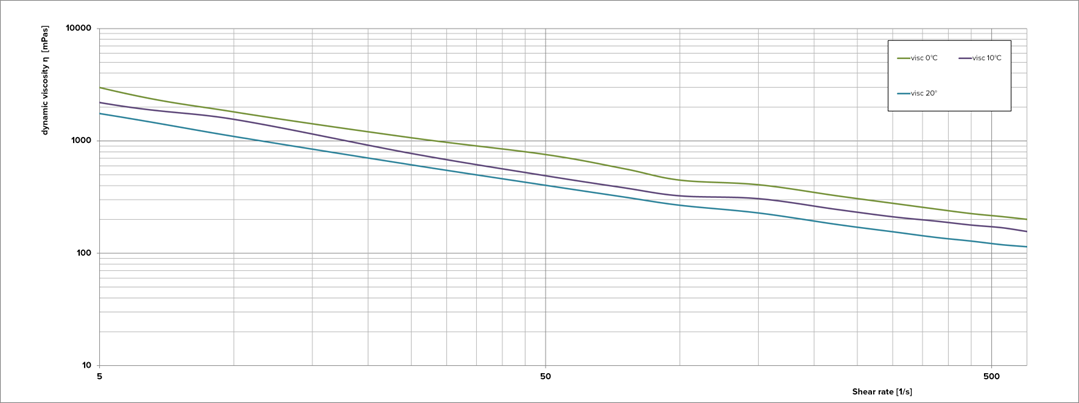
Figure 2: Viscosity curves of a foam agent at different temperatures
Figure 2 shows an example of different dynamic viscosities of a foam agent at different temperatures.
AIR ENTRAPMENT
Another major challenge when handling high-viscosity foam agents is air entrapment. In the case of high viscosity, pseudoplastic foam agents, the air bubbles, that may form during transportation or refilling can remain in the liquid and therefore have an impact on the proportioning rate. A volume of 10% entrapped air means a 10% reduction in the proportioning rate so that a nominal rate of 3% effectively becomes 2.7%.
In the following, different types of proportioning systems will be compared with regard to the effects of the transition from a Newtonian to a highly viscous, pseudoplastic foam agent.

Figure 3: Air trapped inside a high viscous foam agent
VENTURI PROPORTIONER
When using self-inducting Venturi proportionersthe limiting factor for switching to a highly viscous foam agent will be the limited suction capability of the Venturi device. Suction lines will generally need a large diameter and be very short if they are to functional at all, as the suction capability of the system is only generated by the water flow. It is also to be expected that the pressure drop in the extinguishing water line will be very high.
BLADDER TANK WITH WIDE RANGE PROPORTIONER
If a bladder tank with a wide range proportioner is to be used after the conversion to FFF agents, the pressure drop in the connecting line between bladder tank and proportioner may be a limiting factor due to the friction loss. In any case, the pipework of the foam concentrate line and the Venturi orifices will need adaptation to the high viscosity of the foam agent. The use of wide range proportioners with a gear pump, in which excess foam agent is returned to the foam agent tank, is very common. As with all systems, suction and foam agent injection lines must be enlarged in diameter to allow a better flow of highly viscous foam agents. Otherwise, the adjustments of the wide range proportioners must be adapted to the properties of the new foam agent, to assure correct proportioning rates at varying flows. Gear pumps generally work well with liquids of higher viscosity. However, a higher back pressure of an extinguishing system leads to foam concentrate leakage at low flow rates.
ELECTRONIC PROPORTIONER
Electronic proportioners with a gear pump, in which excess foam agent is returned to the foam agent tank, will need an adaptation of the suction and foam agent injection lines. Otherwise, the system will need to be recalibrated to the properties of the higher viscous foam agent.
MECHANICAL PROPORTIONER
Proportioning systems using a water motor with a gear pump will need new pipe work to accommodate the highly viscous foam agent. In addition, the minimum and maximum water flows must be reviewed, as gear pumps have a varying amount of foam concentrate leakage dependent on the water flow and the back pressure in the extinguishing water system. High back pressures and low water flows may have an increased effect on the leakage, so the dimensions of the gear pump for the required water flows should be reviewed.
When using a water motor driven proportioner with a piston pump, the suction line between the foam agent tank and the pump must be adapted. Otherwise, no changes need to be made, as the piston pump does not have any leakage. Suppliers of water motor driven proportioners with a piston pump use two different pump types. One of them is regular industry pumps designed for pumping low-viscosity Newtonian fluids such as water or former AFFF agents. The second type are pumps that are specifically designed for high-viscosity pseudoplastic fluids such as FFF agents. The latter generally have a higher efficiency than the usual industry pumps when using high-viscosity foam agents.
The FireDos GEN III water motor driven proportioning systems use exclusively in house developed piston pumps that are designed and tested for use with low viscous Newtonian and highly viscous pseudoplastic foam agents. In addition, all systems are equipped with foam agent return lines for eco-friendly testing of the of the proportioning rate without the need to generate premix or foam.
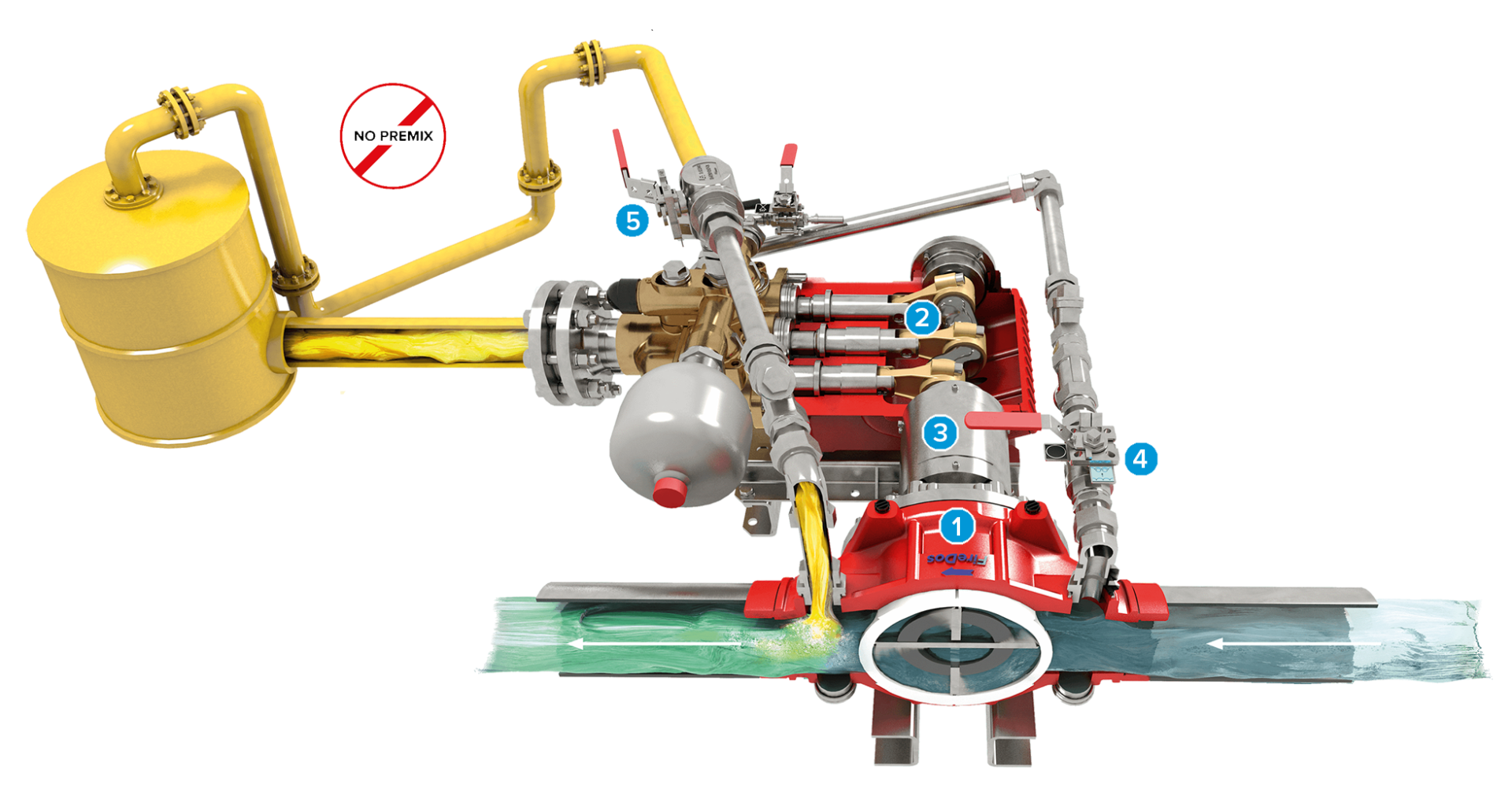
Figure 4: Water motor driven proportioner with a piston pump and a foam return line for eco-friendly testing of the proportioning rate
1 = water motor 2 = proportioning pump 3 = coupling 4 = ball valve 'flushing' 5 = ball valve 'returning / proportioning'
For all proportioning systems it should be observed that the above-mentioned viscosity curves for the proportioners and the foam agents are compatible. A changeover from a Newtonian to a high-viscosity foam concentrate is possible for almost all proportioning technologies with the right planning. The changeover must be carefully planned and carried out, and it is recommended to involve specialized companies for the changeover.
This article has originally been published in International Fire Fighter, March 2024.
This might also be of interest for you:
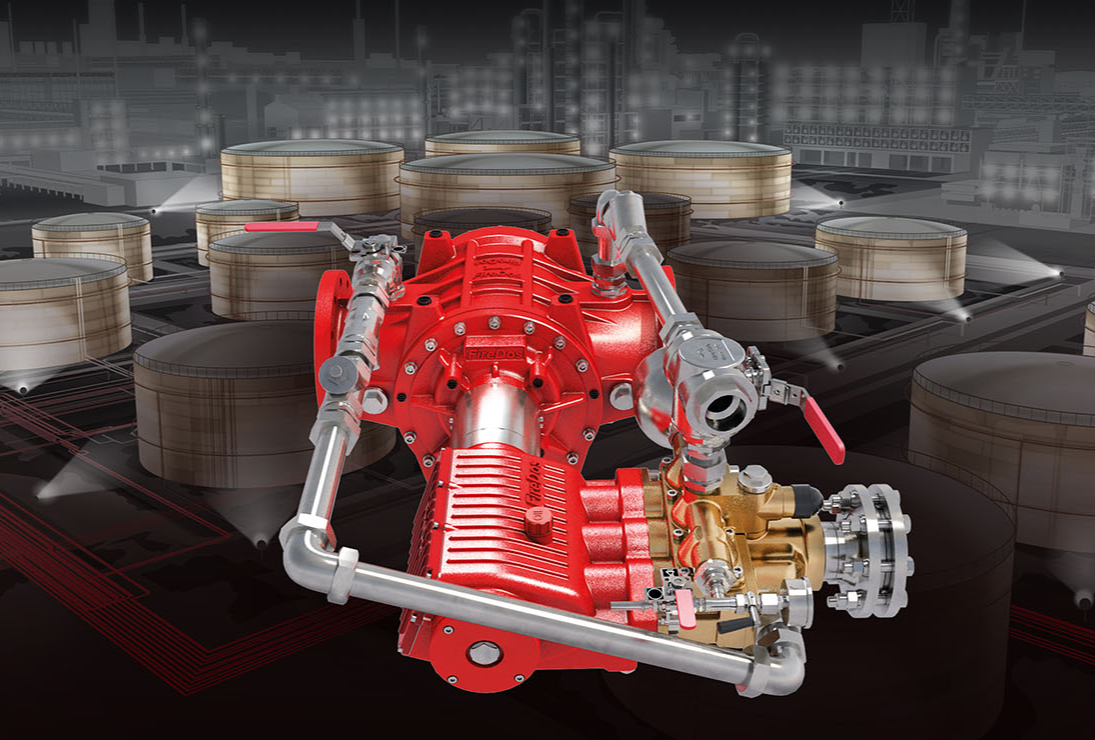
Stationary Foam Proportioners
Inrease performance, save costs: Learn more about the advantages.
View more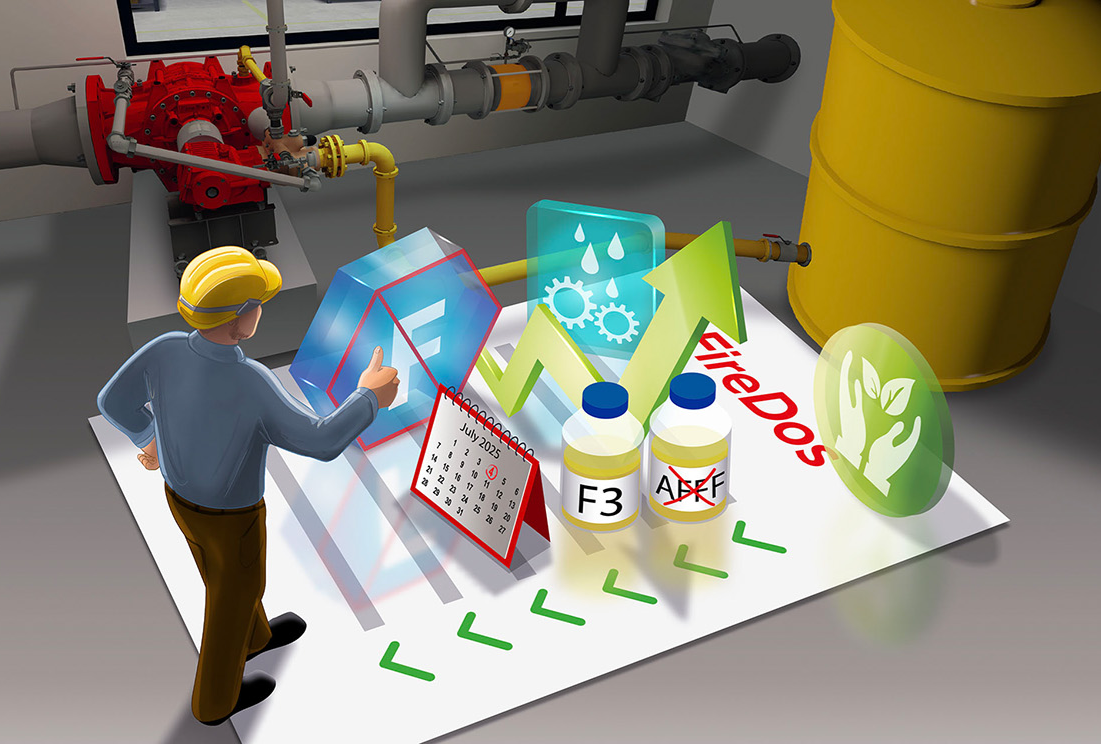
Consulting package "Fluorine free"
Learn how to retrofit your extinguishing system to fluorine free foam agents.
View more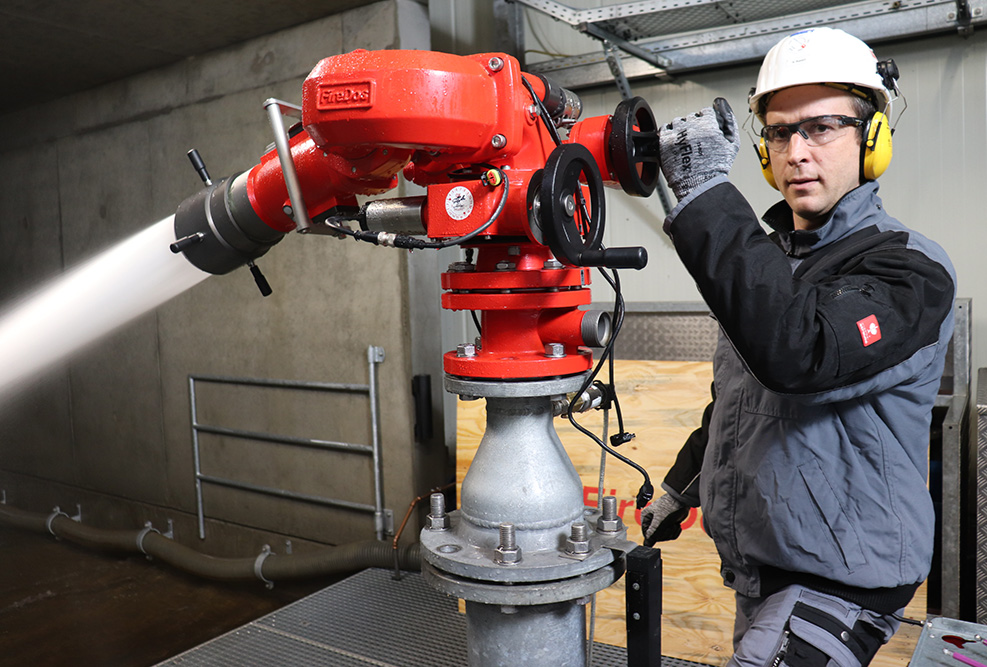
FireDos Service Team: Always there for you
From planning to maintenance: We are happy to assist you.
View more